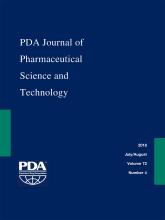Research ArticleResearch
Determination of the Acceptable Ambient Light Exposure during Drug Product Manufacturing for Long-Term Stability of Monoclonal Antibodies
Lin M. Luis, Yuzhe Hu, Camellia Zamiri and Alavattam Sreedhara
PDA Journal of Pharmaceutical Science and Technology July 2018, 72 (4) 393-403; DOI: https://doi.org/10.5731/pdajpst.2018.008581
Lin M. Luis
Late Stage Pharmaceutical Development, Genentech Inc., a Member of the Roche Group, South San Francisco, CA, USA
Yuzhe Hu
Late Stage Pharmaceutical Development, Genentech Inc., a Member of the Roche Group, South San Francisco, CA, USA
Camellia Zamiri
Late Stage Pharmaceutical Development, Genentech Inc., a Member of the Roche Group, South San Francisco, CA, USA
Alavattam Sreedhara
Late Stage Pharmaceutical Development, Genentech Inc., a Member of the Roche Group, South San Francisco, CA, USA

Reference
- 1.↵
- 2.↵Q1B I. Stabilty Testing: Photostability testing of new drug substances and products. www.ich.org/fileadmin/Public_Web_Site/ICH_Products/Guidelines/Quality/Q1B/Step4/Q1B_Guideline.pdf1996.
- 3.↵
- Carvalho T. C.,
- Escotet M. L.,
- Lin J.,
- Sprockel O. L.
- 4.↵
- Templeton A. C.,
- Xu H.,
- Placek J.,
- Reed R. A.
- 5.↵
- Baertschi S. W.,
- Clapham D.,
- Foti C.,
- Jansen P. J.,
- Kristensen S.,
- Reed R. A.,
- Templeton A. C.,
- Tønnesen H. H.
- 6.↵
- 7.↵
- 8.↵
- Dilley K.
- 9.↵
- 10.↵
- 11.↵
- 12.↵
- Folzer E.,
- Diepold K.,
- Bomans K.,
- Finkler C.,
- Schmidt R.,
- Bulau P.,
- Huwyler J.,
- Mahler H. C.,
- Koulov A. V.
- 13.↵
- 14.↵
- Kabat E. A.,
- Wu T. T.
- 15.↵
- 16.↵
- Pan H.,
- Chen K.,
- Chu L.,
- Kinderman F.,
- Apostol I.,
- Huang G.
- 17.↵
- 18.↵
- Bane J.,
- Mozziconacci O.,
- Yi L.,
- Wang YJ.,
- Sreedhara A.,
- Schoneich C.
- 19.↵
- Li Y.,
- Polozova A.,
- Gruia F.,
- Feng J.
- 20.↵
- 21.↵
- 22.↵
- 23.↵
- Mallaney M.,
- Wang S. H.,
- Sreedhara A.
- 24.↵
- 25.↵United States Pharmacopeia. USP 36 NF. Vol. 312013, 2160–2165.
- 26.↵
- 27.↵
- 28.↵
- 29.↵
- 30.↵
- 31.↵
- 32.↵
- 33.↵
- Gao X.,
- Ji J. A.,
- Veeravalli K.,
- Wang Y. J.,
- Zhang T.,
- Mcgreevy W.,
- Zheng K.,
- Kelley R. F.,
- Laird M. W.,
- Liu J.,
- Cromwell M.
- 34.↵
In This Issue
PDA Journal of Pharmaceutical Science and Technology
Vol. 72, Issue 4
July/August 2018
Determination of the Acceptable Ambient Light Exposure during Drug Product Manufacturing for Long-Term Stability of Monoclonal Antibodies
Lin M. Luis, Yuzhe Hu, Camellia Zamiri, Alavattam Sreedhara
PDA Journal of Pharmaceutical Science and Technology Jul 2018, 72 (4) 393-403; DOI: 10.5731/pdajpst.2018.008581
Determination of the Acceptable Ambient Light Exposure during Drug Product Manufacturing for Long-Term Stability of Monoclonal Antibodies
Lin M. Luis, Yuzhe Hu, Camellia Zamiri, Alavattam Sreedhara
PDA Journal of Pharmaceutical Science and Technology Jul 2018, 72 (4) 393-403; DOI: 10.5731/pdajpst.2018.008581
Jump to section
Related Articles
- No related articles found.
Cited By...
- No citing articles found.





